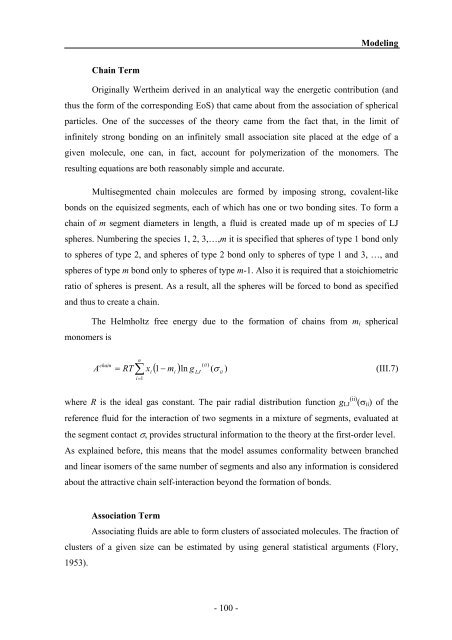n - PATh :.: Process and Product Applied Thermodynamics research ...
n - PATh :.: Process and Product Applied Thermodynamics research ...
n - PATh :.: Process and Product Applied Thermodynamics research ...
You also want an ePaper? Increase the reach of your titles
YUMPU automatically turns print PDFs into web optimized ePapers that Google loves.
Chain Term<br />
Modeling<br />
Originally Wertheim derived in an analytical way the energetic contribution (<strong>and</strong><br />
thus the form of the corresponding EoS) that came about from the association of spherical<br />
particles. One of the successes of the theory came from the fact that, in the limit of<br />
infinitely strong bonding on an infinitely small association site placed at the edge of a<br />
given molecule, one can, in fact, account for polymerization of the monomers. The<br />
resulting equations are both reasonably simple <strong>and</strong> accurate.<br />
Multisegmented chain molecules are formed by imposing strong, covalent-like<br />
bonds on the equisized segments, each of which has one or two bonding sites. To form a<br />
chain of m segment diameters in length, a fluid is created made up of m species of LJ<br />
spheres. Numbering the species 1, 2, 3,…,m it is specified that spheres of type 1 bond only<br />
to spheres of type 2, <strong>and</strong> spheres of type 2 bond only to spheres of type 1 <strong>and</strong> 3, …, <strong>and</strong><br />
spheres of type m bond only to spheres of type m-1. Also it is required that a stoichiometric<br />
ratio of spheres is present. As a result, all the spheres will be forced to bond as specified<br />
<strong>and</strong> thus to create a chain.<br />
The Helmholtz free energy due to the formation of chains from mi spherical<br />
monomers is<br />
A<br />
chain<br />
= RT<br />
n<br />
∑<br />
i=<br />
1<br />
x<br />
i<br />
( − m )<br />
i<br />
( ii)<br />
LJ<br />
1 ln g ( σ )<br />
(III.7)<br />
ii<br />
where R is the ideal gas constant. The pair radial distribution function gLJ (ii) (σii) of the<br />
reference fluid for the interaction of two segments in a mixture of segments, evaluated at<br />
the segment contact σ, provides structural information to the theory at the first-order level.<br />
As explained before, this means that the model assumes conformality between branched<br />
<strong>and</strong> linear isomers of the same number of segments <strong>and</strong> also any information is considered<br />
about the attractive chain self-interaction beyond the formation of bonds.<br />
Association Term<br />
Associating fluids are able to form clusters of associated molecules. The fraction of<br />
clusters of a given size can be estimated by using general statistical arguments (Flory,<br />
1953).<br />
- 100 -



